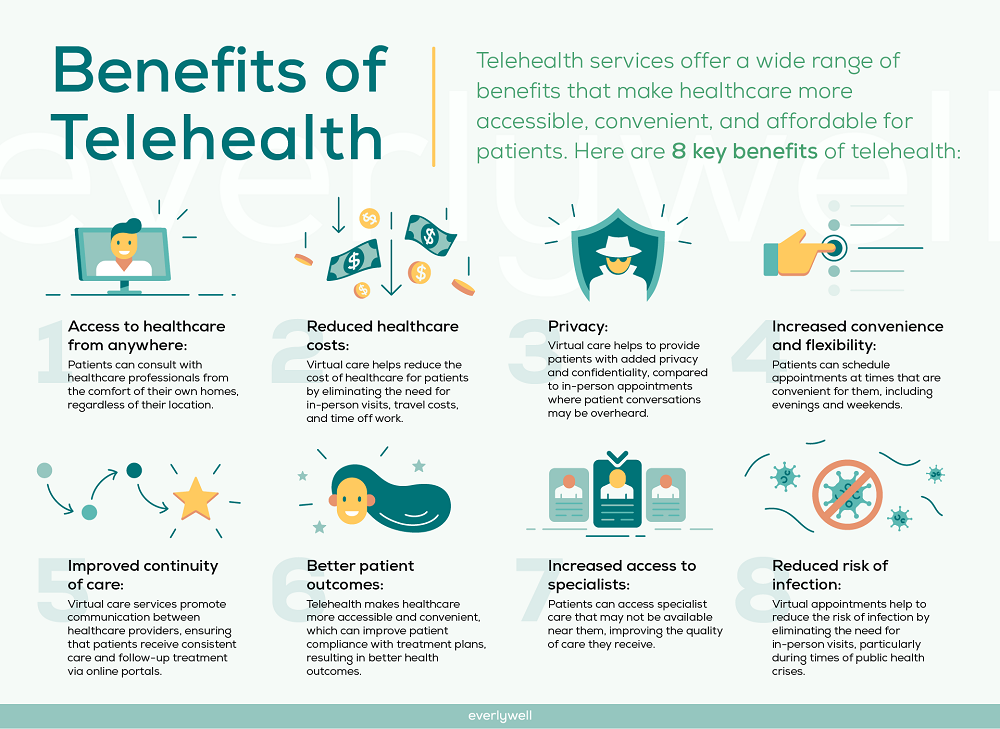
Is telehealth cheaper than an office visit?
Written on December 19, 2022 by Sendra Yang, PharmD, MBA. To give you technically accurate, evidence-based information, content published on the Everlywell blog is reviewed by credentialed professionals with expertise in medical and bioscience fields.
Table of contents
- What is telehealth?
- Telehealth is a cheaper, more affordable option than an office visit
- Conditions treated with telehealth
- Tips to make telehealth more enjoyable
- More on telehealth and Everlywell
- Related content
What is telehealth?
Telehealth, sometimes referred to as telemedicine, is a broader term that includes telemedicine [1-4]. Telehealth uses communication technologies to connect providers to patients to provide health care without in-person office visits [1-3]. Telehealth is primarily completed in a “virtual” format, such as online on a computer, tablet, or smartphone, or through telephone calls and text messaging [1-4].
In some cases, an in-person office visit may be necessary. However, telehealth has many benefits in circumstances where a virtual visit is right for your healthcare needs [1-4]. Telehealth is convenient and more accessible than seeing a provider in person. Virtual visits allow you to receive care wherever you are, whether at home, work, or on vacation. You may even see a health provider after regular office hours. Telehealth can help reduce or even eliminate the need for travel, time off work, and child care. Telehealth can also increase your access to specialist providers located further away from where you live.

Telehealth is a cheaper, more affordable option than an office visit
Several studies found that telehealth may offer some patients a more affordable option for medical care [4-7]. A virtual telehealth appointment typically costs around $40 to $50, while in-person care can cost as much as $176 per visit [4]. Telephone follow-up visits can offer a more efficient option than office-based visits that is acceptable and affordable to patients [5]. Telehealth provides a lower cost for virtual care without an increase in overall follow-up rates or antibiotic use when compared with urgent or primary care [6]. Telemedicine may improve access for patients with transportation, parking, or cost barriers to in-office clinic visits [7].
Your specific cost will depend on various factors, such as your insurance, how much the provider charges, the type of facility, and what tests or services you are getting [3]. Many insurance providers may have telehealth coverage, though states’ policies may differ [3].
Here are some ways you can keep your telehealth costs low [1,3]:
- Check with your medical insurance to see if telehealth is covered. If so, use your medical insurance for the telehealth visit.
- Check with your prescription coverage to see if your prescription is covered.
- Look for prescription discounts if you are paying out of pocket.
- Compare different telehealth providers. Take a look at Everlywell's Virtual Care Visit.
- Search for low-cost lab test options, if needed.
Conditions treated with telehealth
You can use telehealth to connect with your provider and address many conditions [1-3]. You can get diverse specialized care for the management of ongoing health issues for chronic health conditions. However, telehealth is not for everyone or all medical conditions. It is essential that you speak with a healthcare provider to see whether telehealth is the right option for you.
Conditions and care that you can receive with telehealth may include [1,2]:
- Lab test results
- Mental health therapy, counseling, and medication management
- Conditions such as migraines or urinary tract infections
- Skin assessments and disorders
- Prescription medication management
- Health conditions like colds, coughs, and stomach aches
- Nutritional counseling
- Remote monitoring services for chronic disease management, such as diabetes, high blood pressure, and elevated cholesterol
Tips to make telehealth more enjoyable
Here are some tips that can help make your telehealth visit more enjoyable [3]:
- Test your equipment ahead of time. Before your scheduled virtual visit, try testing your equipment, such as your camera, computer, or phone. Having a clear picture and sound during your visit will help your provider address your concerns more easily and effectively.
- Ensure that your internet connection is stable. Use the best possible internet connection available to you by using a wired connection to your router. If you are using Wi-Fi, try to be close to the internet router and minimize other connected devices for improved connectivity during the virtual visit.
- Limit distractions. Try to find a quiet space with little to no distractions during the visit. Fewer interruptions will help focus on getting your healthcare issues and concerns addressed by the healthcare provider.
- Prepare for your virtual visit. Being prepared for your telehealth visit will make it easier for you and your provider to discuss your concerns. Remember to make a list of your questions and concerns.
More on telehealth and Everlywell
Telehealth has grown significantly in the past few years to allow people to receive the health care they need to live healthy, happy lives.
Everlywell can help you with access to telehealth through a Virtual Care Visit, whether you have insurance or not. Schedule your appointment and determine your coverage eligibility by visiting Everlywell. Telehealth via Everlywell lets you speak with a qualified healthcare provider based on your availability from the comfort of your home through a video call.
Related content
What drugs can telehealth providers prescribe?
Can you get flu treatment online?
Can you treat the flu without going to the doctor or healthcare provider?
Remote patient monitoring for diabetes explained
References
- Health Resources & Services Administration. What is telehealth? Telehealth.HHS.gov. Last updated June 29, 2022. Accessed December 14, 2022. URL
- MedlinePlus. Telehealth. Last updated May 4, 2020. Accessed December 14, 2022. URL
- National Institutes of Health. Telehealth: What is it, how to prepare, is it covered? National Institute on Aging. Last reviewed August 26, 2020. Accessed December 14, 2022. URL
- Rehm J. Telemedicine: The cost-effective future of healthcare. AJMC. December 6, 2016. Accessed December 14, 2022. URL
- Peng T, Gleason N, Gonzales R. A comparison of patient-reported outcomes related to telephone follow-up visits and conventional office visits in medical specialty practices. Telemed J E Health. 2021;27(7):747-754. doi: 10.1089/tmj.2020.0147. URL
- Lovell T, Albritton J, Dalto J, Ledward C, Daines W. Virtual vs traditional care settings for low-acuity urgent conditions: an economic analysis of cost and utilization using claims data. J Telemed Telecare. 2021;27(1):59-65. doi:10.1177/1357633X19861232. URL
- Reed ME, Huang J, Graetz I, et al. Patient characteristics associated with choosing a telemedicine visit vs office visit with the same primary care clinicians. JAMA Netw Open. 2020;3(6):e205873. doi:10.1001/jamanetworkopen.2020.5873. URL